Two Nigerian letters from SpainNigerian letters don't come exclusively from Nigeria, although this country still plays a large role in this "industry". Therefore, a Nigerian letter from Spain is not exceptional. Incidentally, the idea behind Nigerian letters and other advance-fee scams is at least as old as the Spanish Prisoner scam of the 19th century. In a geographic sense, this Spanish Nigerian letter is a return to origins. What makes this letter unusual is that it came to me as a paper letter by ordinary (snail) mail. It may be interesting to examine its characteristics. The choice of sending this letter on paper may show the desperation of these guys, who have to send out millions of similar letters by e-mail before anyone ever answers. However, fraud by ordinary mail is as old as the postal service itself, and has a long tradition of different types of scams. Example 1The envelope is a paper envelope with a regularly cancelled postage stamp (from Malaga) and a transparent window for the destinatary address (printed on the letter), which in itself shows that these guys are too lazy to write separate envelopes and match them with the right letters. It is satisfying to me to think that these guys did waste money on the postage stamp (0.75€). Hardly surprising, there is no sender on the envelope. 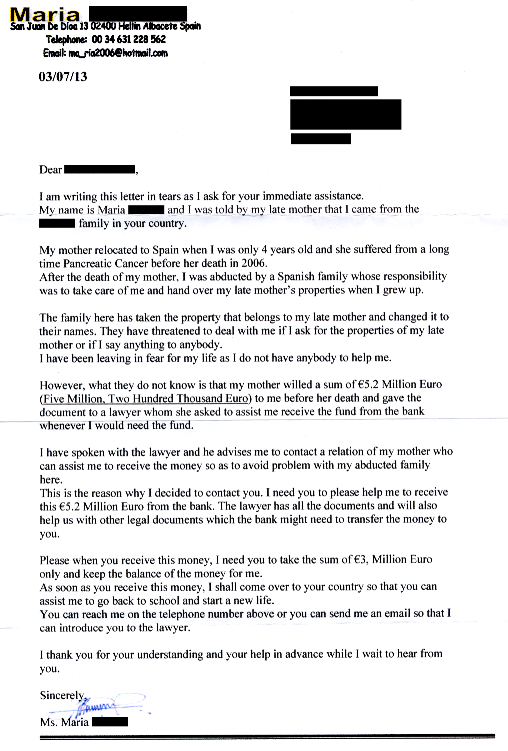
The letter itself is printed on a color inkjet printer. The sender's name is given as Maria XXXXXX (the family name is the same as the destinatary's family name, to make the letter somewhat credible) and the address is in Albacete. Since the letter was posted in Malaga, I guess that Maria traveled from Albacete to Malaga (5 hours by train) to post her letter, then traveled back home (another 5 hours). I know enough not to write my own address here, so I blanked out the family name and my address in the above image. Not that my postal address is a secret, but at least a would-be scammer will have to do her homework before she can send me a letter. The OCRd text of the letter follows, to make it easier to read and searchable by web content indexes: Maria XXXXXX The story in the letter is no different from thousands of similar Nigerian letters sent every day through the Internet. Nothing special here. Once you have seen a few, you recognize them all. This letter is slightly more personalized by adding the intended victim's name a few times, but this is easily done with a simple script that goes through a list of mail addresses and writes "personalized" letters. Nothing different from the "personalized" publicity ads that have been around for decades. The sender's address is given as Maria XXXXXX, San Juan de Dioa 13, 02400 Hellin Albacete Spain, phone 0034 631 228 562. If you are in the area, you may wish to call them or pay a visit there. There is no "San Juan de Dioa" in Hellin, but there is a Calle San Juan de Dios 13, where businesses, including a dental clinic, are registered. A slightly different phone number traces back to the General Hospital in Albacete. The e-mail address is (somewhat predictably) ma_ria2006@hotmail.com - just the kind of address a crook would get in the hope of avoiding being traced. I don't think that these guys are so monumentally stupid that they are using a working post address, so it is very likely that any letter mailed to the above address will be returned as undeliverable, and that the e-mail address is the only working way to contact them. After all, who would bother to send a reply by letter when you can send it by e-mail? The choice of a female fictional character is also natural. A woman can be, instinctively, regarded as less likely to be playing a scam, and more likely to elicit feelings of compassion in the intended victim. However, I have had my share of daughters of deceased Nigerian foreign ministers and African princesses in distress. Note that these guys wrote "I was told by my late mother that I came from the XXXXXX family in your country". Again, they are a bit too generic to be credible. I spent most of my adult life in four different countries and shorter periods in a dozen more countries, none of which is my country of origin, so what is my country? The English language standards of these guys have improved, compared to typical Nigerian letters. They must have realized that a nearly illiterate ex Prime Minister or President's daughter is not very credible. However, guys, you don't say "I have been leaving in fear for my life". The word you want is "living". You also don't say "receive the fund from the bank". It is "funds". And there are more giveaways. 
The signature is an obvious problem for these guys. It either has to be completely illegible (so that they can use it with any actual name) or it can say "Maria" but nothing more should be legible (because the family name of the sender is of course "personalized" and the same as the addressee's family name). Our guys chose the second alternative. A closer look, however, shows that the signature is a poor quality scan printed out on an inkjet printer like the rest of the letter. Example 2The following example was addressed to my wife at our shared address. Two samples are not enough for a statistical analysis, however it sounds remarkable that the only two Nigerian letters delivered to my addresses by ordinary mail come from the same country, possibly from the same criminal organization still active after several years. 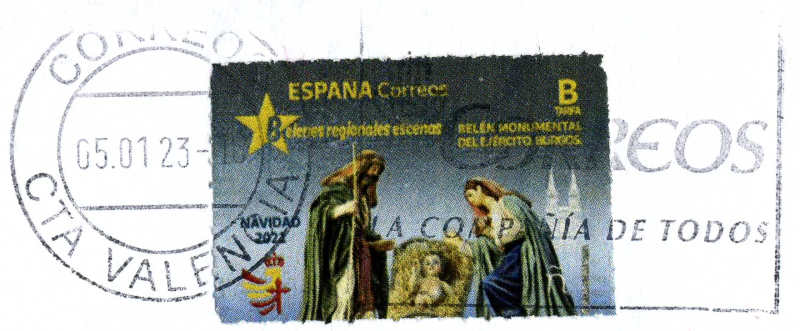
And a detail of the postage stamp: 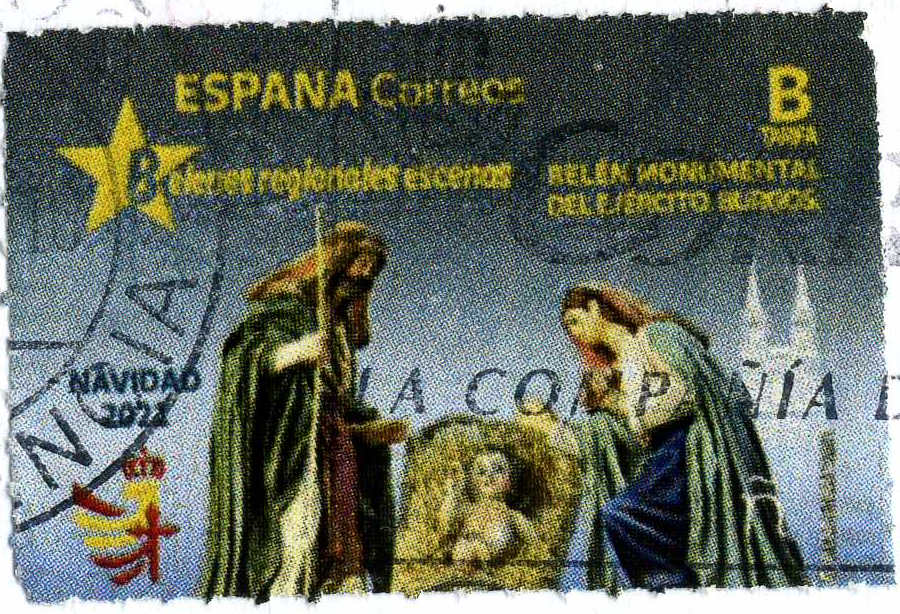
The postage stamp on the envelope of the letter does look like a poor-quality forgery. I am not familiar with Spanish postage stamps, but this one is so poor that I hardly believe it can be genuine. If it is, the Spanish Mail Service really does not care that anyone can print fake postage stamps at home and successfully use them to send mail. The text is fuzzy like the image, there are no UV-fluorescent marks or fibers, the margins are neither perforated nor straight-cut, and it appears to be printed on a cheap ordinary paper label. 
This is an image available on the web of the postage stamp. However, this image is a bit too good to be a true photograph of the postage stamp. It may instead be a promotional image, much too "optimistic", released by the Spanish mail service. 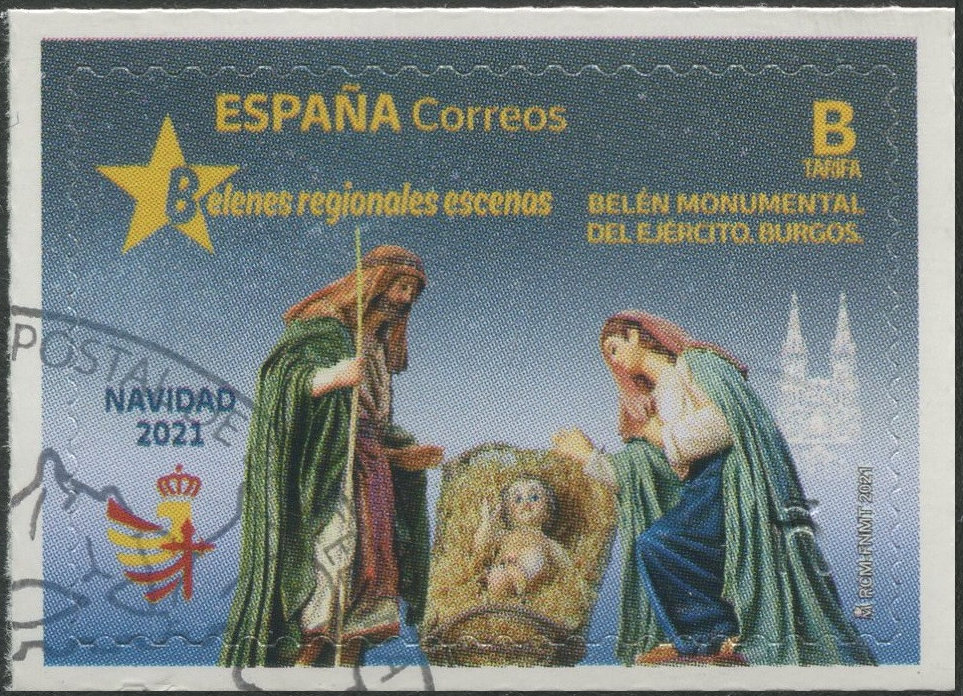
And this is instead, likely, a true picture of the postage stamp, complete with a printed area larger than the perforation. The area outside the perforation was designed to remain attached to the backing of the self-adhesive stamp. There is no actual perforation in the stamp in my possession. The actual print quality in this image is much coarser, and more similar to the stamp in my possession. So is the postage stamp on the envelope of this Nigerian letter a poor forgery, or simply a genuine postage stamp of exceptionally poor quality? I will leave the question unanswered. If a forgery, I do not believe that the letter was posted into a mail box and accepted by the Spanish mail system. It would appear instead that these scammers have a way to bypass the post office and to inject wholesale amounts of letters with fake postage stamps directly into the Spanish postal sorting system. This obviously requires the complicity of postal employees. In this case, the cancel stamp could also be a fake, but it looks real good, in spite of being printed with a non-fluorescent ink, and there is a moderate chance it is authentic. The cancel was obviously printed on both the stamp and the envelope, and carries a realistic date (less than two weeks before the letter was delivered in Sweden). 
Once the letter entered the stream of processed mail, it passed through the postal systems of multiple countries without further checks and verifications. The above digitally enhanced image shows the sorting barcodes (barely visible to the eye, but authentic and printed in UV-fluorescent ink) and "POSTNORD" overprint at the bottom right of the envelope, showing that this letter has been processed by the Scandinavian mail system. If anyone can read this barcode, I would like to know what it says. It is actually the only fully credible proof of processing by a legitimate mail system. Were it not for the Spanish (fake or real) stamp and cancel, it could in principle have been injected into the mail system of just about any country, using any weak link and/or corrupt postal officials of the mail system. The Spanish mail should probably tighten up their (obviously insufficient) security features. 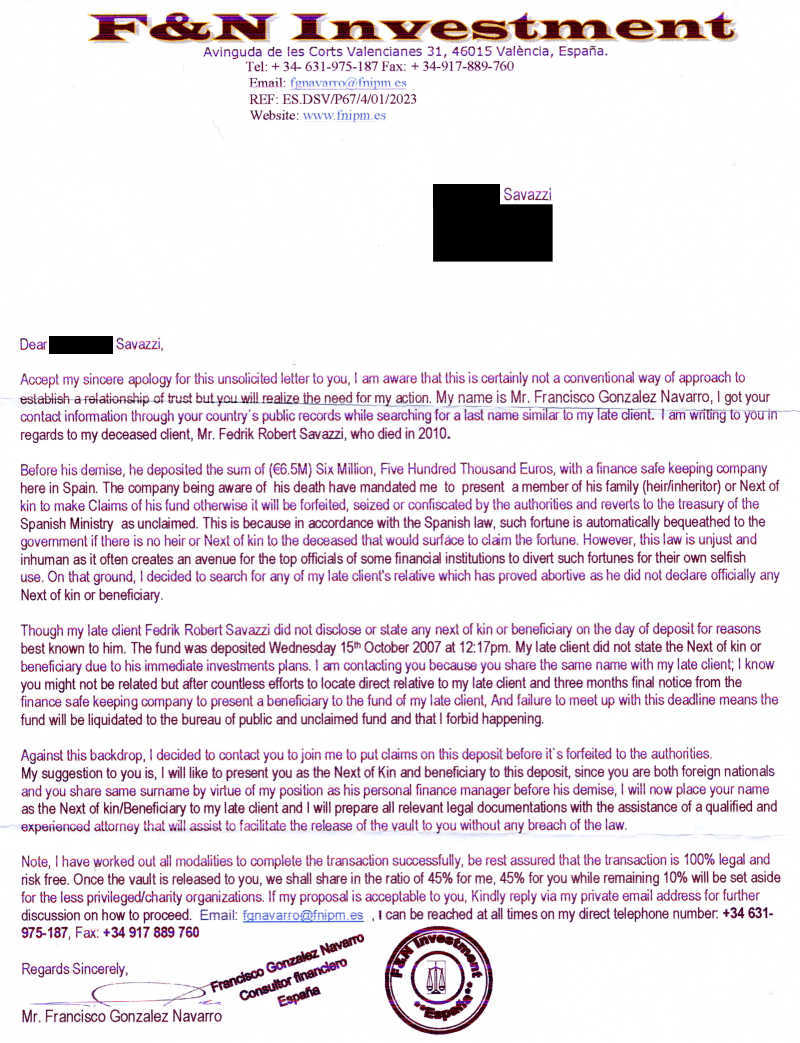
The letter itself is quite unremarkable. It is a word-by-word exact copy of a Nigerian scam that has been going around the Internet for many years. A Google search finds several examples. Only the name and address of the destinatary change, and occasionally the name and contact details of the nonexistent lawyer. The OCRd text, to make it searchable by web spiders: F&N Investment 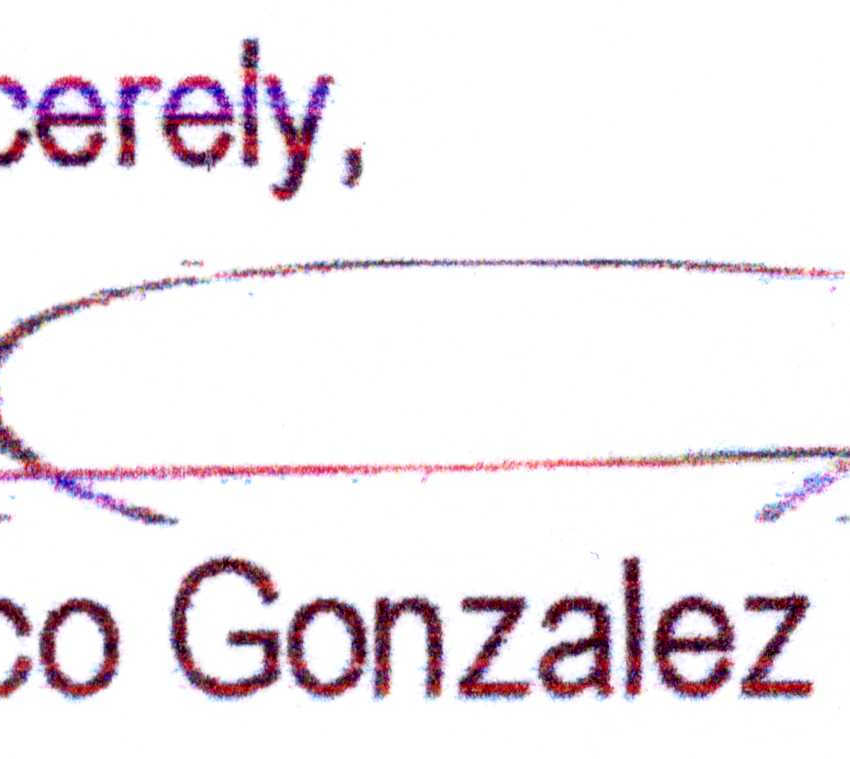
The signature and stamp at the bottom of the letter, like the letter heading, are printed on the same color inkjet printer, with an over-used and worn-out ink cartridge and head, used for the text. By itself, even if one should believe the contents of the letter, this is the final giveaway. These guys must really be running out of money if they cannot use a better printer, cannot afford a new ink cartridge, or are too short on manpower to write fake signatures with an ordinary pen. Note also how the bottom "loop" of the signature disappears when approaching the printed name. This is what happens when a picture has been carelessly cropped or overlaid with text to fit into the available space. To the credit of the scammers, I can note that they have finally learned that it is unlikely that an official letter from a lawyer/administrator located in one city will be posted from a different city hundreds of Km away. At least, this time both the stamp on the envelope and the (non-existent) Mr. Navarro are from the same city. Except that this time another detail jumps back to bite the scammers in their big fat rear bumpers: the Fax area code 917 is Madrid, not Valencia. Who uses Fax anymore? By giving out a Fax number, the scammers provide yet another giveaway. One last comment is that Mr. Navarro's letter is a proposal to commit a crime of conspiracy to steal a large sum of money and to defraud the Spanish state, regardless of what Mr. Navarro maintains. This is just one more reason to never enter into such an agreement, even in the astronomically unlikely case that there really existed a safe containing unclaimed cash. By agreeing to Mr. Navarro's proposal, you would give the scammers a way to threaten you with police and judiciary consequences, as a "convincer" to part with your hard-earned money in order for them to keep silent on your "crime". They might even contact you pretending to be police officers and request you to pay a large "fine". The second point with this scam, of course, is the endless number of requests for fees, bribes etc to pay to the scammers before you can get your share of the (non-existent) money. ConclusionsIt is hard to think how anyone would fall for this scam, given the large amount of giveaways and the lack of credibility of the whole story. However, if the scammers still keep sending out these letters, it means that once in a while a simple soul falls for it, and is unable to cope with the fallout. Just in case, I am making this information publicly available on my site. There is a simple way to make these scam attempts ineffective: regardless of what the scammers say, never send them any money or personal information that they do not already have (especially bank account numbers, but just to be safe, do not volunteer any personal contact information). If you must give information, feed them only fake information. It's only fair. Internet resources
|